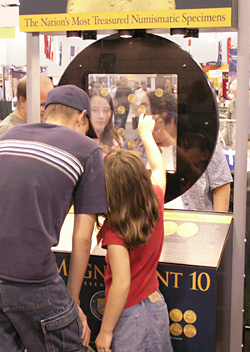|
"Making Cents"
The Signal
Saturday, August 26, 2006
| T |
The headline display consisted of ten 1933 $20 gold coins in a large, circular, two-sided panel with a detailed description. What made the exhibit unique and especially valuable — perhaps in the tens of millions of dollars — is that the existence of these 10 coins was unknown until recently. In 2002, what was believed to be the King Farouk specimen of the only legally held 1933 $20 gold piece was sold for a record $7.5 million. The current group of coins was confiscated by the Mint, which allowed them to be displayed at the convention. The battle for title to the coins should prove to be not only epic, but also very expensive.
Nearby were several other rather special coin displays, including a case with two 1913 Liberty Head nickels. One was the Aubrey Beebe specimen, purchased at an ANA convention in San Diego in the late 1960s for $46,000 — a record price at the time for the coin. Only five 1913 Liberty head nickels are known. The actual check was included in the exhibit. The coin was donated to the ANA museum in Colorado Springs when Beebe died several years ago. A second 1913 nickel in the case was the Walton specimen, which until three years ago was "lost." The owner died in a car crash in 1962 and his family unknowingly kept the coin hidden until it was examined and authenticated at the 2003 ANA convention. The value of these two coins is about $3 million each.
Another display featured a video and a brilliant specimen of a 1794 silver dollar. Not only was it a rare coin, but the display went on to explain that it was probably the very first silver dollar made at the United States Mint. It is valued at well over $1 million.
A very rare 1927-D $20 gold piece was featured in a four-sided display case. It is the rarest of the Denver minted $20 gold coins, as well as the finest known specimen. It, too, is valued at well over $1 million.
The first United States gold coin, issued privately before the U.S. Mint opened, was the 1787 Brasher doubloon. It was made by famed New York goldsmith and engraver Ephraim Brasher. His personal stamp, "EB," appears on the eagle's breast on the coin. It is one of 10 known Brasher counterstamped gold coins, but the only one with the initials on the eagle's breast and thus believed to be the first one made. It could be viewed from all sides, as it was displayed upright in a numismatic capsule.
The largest exhibit in the rare coin grouping was a four-paneled display of pioneer gold coins, two gold ingots of the 1850s, and the first gold coin from the Denver Mint in 1906.
These special displays were at the forefront of the exhibition area, which included dozens of competitive and non-competitive exhibits of coins, currency and tokens. In addition, several dozen foreign coin-issuing countries, ranging from Canada to Austria, Great Britain, Bermuda, Australia, China and France, offered examples of their current coinage and created displays of their national coinage and paper money.
The highest dollar-value display was the belonged to the federal Bureau of Engraving and Printing, which attends every annual ANA convention. Its billion-dollar exhibit includes two $500 million bonds, two uncut sheets of $1,000 bills, an uncut sheet of $100,000 bills, and more modern uncut sheets of $1, $2, $5, $10, $20 and $50 bills, which were available for purchase. The display included a printing press used to print specialty items such as souvenir cards. The cards printed at the ANA shows are limited in number and are quite valuable.
The bourse floor included several hundred coin dealers from around the world. Their merchandise displays ranged from the rare to the mundane. But the glitter of high-end silver and gold coins surely added a eyeful for the many visitors who attended the show. (Admission is free at ANA shows.)
The coins offered for sale in the convention auction also made for a spectacular display — but only under the watchful eyes of the auction company, which allowed the coins to be seen by registered bidders before being offered for auction. During the auction, each coin or lot was displayed on a video screen for the audience in the auction room to view. The more valuable coins were prominently featured with full-color photos in the auction catalog.
An average citizen attending the show and viewing all the displays, auction lots and dealers' cases would spend a whole day being dazzled by the most beautiful items — other than diamonds, perhaps — assembled under one big roof.
Next year's summer ANA convention will be held in Milwaukee.
Dr. Sol Taylor of Sherman Oaks is president of the Society of Lincoln Cent Collectors and author of The Standard Guide to the Lincoln Cent. Click here for ordering information.
©2006, THE SIGNAL · ALL RIGHTS RESERVED.

![[Most Recent Quotes from www.kitco.com]](http://www.kitconet.com/images/quotes_special.gif)

